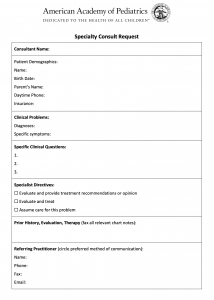Referral for Dermatology/Allergy
Pediatric Allergist

A pediatric allergist is a medical doctor who specializes in managing allergic issues for children. Allergists perform the following procedures to screen patients for allergies and can help patients interpret the results to proceed with allergy management:
- Skin prick testing (SPT): also known as a scratch test, a tiny droplet of an allergen is placed on the skin, then lightly scratched. Allergists wait 15 minutes to observe for a reaction in the form of a hive
- Blood testing: a blood test called Immunocap Specific IgE, measures the concentration of antibodies created in response to the presence of antigen that the body deems harmful
- Oral Challenges: a procedure where a patient is administered incrementally increasing doses of a food or drug to assess if they are tolerant to it.
When experiencing any of the following allergic issues, an allergist can also assist patients in determining the best course of treatment:
- Anaphylaxis, a severe allergic reaction involving one or more bodily symptoms
- Food Allergies, in which a patient may experience any of the following symptoms, including but not limited to urticaria, angioedema, itching, wheezing, or gastrointestinal symptoms, if they are exposed to a food allergen they are allergic to.
- Drug allergies, such as to different medications
- Environmental allergies, to things common in different environments, including pollen, dust, pet dander, and mold.
- Stinging insect allergies, such as to bees
Pediatric allergists also help manage non-IgE mediated allergies and various atopic conditions, including the following:
- Allergic rhinitis, inflammation of the nose in response to allergens in the air and surroundings. This may cause symptoms including stuffy nose or rhinorrhea (a runny nose)
- Asthma, and related issues including therapies, reliever medications, and associated rhinitis or sinusitis
- Atopic Dermatitis (eczema), and all other issues related to eczema, including, contact dermatitis, environmental allergies, etc.
- Eosinophilic GI disorders, and helping patients determine what foods may be causing GI issues
For infants and toddlers specifically, pediatric allergists assist families to determine when and in what form to introduce commonly allergenic foods into the diet, and what strategies and steps to take in the lifestyle and in the home to prevent the development of food allergies. Allergists work closely with families to determine the best course of action for their child’s health needs and help guide families on how to integrate foods back into an infant or toddler’s diet over time and/or in a controlled setting. They are able to update families on the most up-to-date science when it comes to food allergies in this population.
Older populations can participate in studies that utilize immunotherapies (including oral immunotherapy, subcutaneous immunotherapy, or sublingual immunotherapy), which may help research subjects decrease the likelihood of reacting to foods that they are allergic to.
If you would like to refer your patient to a pediatric allergist, American Academy of Allergy, Asthma and Immunology (AAAAI) and American College of Allergy, Asthma, and Immunology (ACAAI) both have information on how to find a local allergist in your community.
Pediatric Dermatologist
A pediatric dermatologist is a medical doctor who specializes in managing issues pertaining to the skin, hair, and nails. Similar to a pediatric allergist, they can also work with patients in managing medical issues, including the following:
- Atopic diseases, such as atopic dermatitis (eczema)
- Urticaria (hives)
Pediatric dermatologists also assist patients with issues specific to that patient’s age group. In infants and toddlers, this can sometimes include
- Infantile hemangioma: blood vessels that may have grown out of control during development, and are likely to create red rubbery lesions on the skin
- Psoriasis: a skin disease that causes itchy, dry patches
- Cradle cap: itchy and/or oily scales that may appear on an infant’s scalp
They may prescribe that you use specific medications or products, including ointments and creams that may help in resolving/improving certain skin conditions. They work closely with a patient’s pediatrician in order to create the best care plan for a patient’s needs.
If you would like to refer your patient to a pediatric dermatologist, American Academy of Dermatology (AAD) has information on how to find a local dermatologist in your community.
